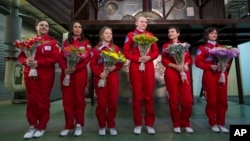A crew of six Russian women have completed an eight-day experiment simulating conditions of long distance space travel – the first test of its kind featuring an all-female crew.
Emerging from the test site - a space capsule at Russia’s Institute for Biomedical Problems in Moscow - the volunteer scientists, ranging in age from 22 to 34 and clad in orange flight suits, saluted their superiors before being presented with flowers and a CD collection of Soviet victory songs from World War II.
During the simulated voyage, the women were tasked with performing a series of scientific experiments in which they largely served as their own subjects.
The crew oversaw a series of biological and psychological tests aimed at calculating the effects of deep isolation in space, and – on a more basic level -- whether they could simply get along for the duration.
The scientists were thrown such curves as adverse weather patterns which delayed their simulated re-entry and extended their mission by a day.
"We know that sometimes cosmonauts have to wait a long time for re-entry, so we were prepared," said flight commander Elena Luchitskaya. "It was hard to but we needed the extra time to complete our work."
First all woman crew
Daryia Kosarova, 27, senior researcher on the mission, said the experience had been an overwhelmingly positive one, and reaffirmed her own childhood ambitions.
"I was always dreaming about space and spaceships...but it was always a distant dream. Now, following this experiment, I think it's one worth trying," says Kosarova.
"And in Russia, I think we need to develop women into the space industry," she added.
Russians have long been forerunners in researching the effects of long distance space voyages but, until this past week, such endeavors only involved mixed gender crews. Moreover, the vast majority of current cosmonauts are male. The U.S. NASA space program fares only slightly better – with just over a quarter of the astronauts women.
Yet Sergei Ponomarev, the scientific director of the "Moon-2015" experiment, argues that based on what he'd observed with the all-female Russian crew, the future in the stars belongs not only to men but women as well.
"From what we've seen, the women worked as one team with no conflicts. This is a really very good crew," says Ponomarev.
"With additional training, this crew could go to the moon, the International Space Station, Mars or other planets"
First woman in space
Soviet premier Nikita Khrushchev famously chastised the US for discrimination against women during the height of the Cold War-era Space Race.
Following Soviet cosmonaut Valentina Tereshkova's historic flight as the first woman in space in 1963, Khrushchev appeared with Tereshkova on Red Square.
"The bourgeoisie always claim that women are the weaker sex," said the Soviet leader at the time. "Look at what she has shown to America's astronauts. She has shown them who is who!"
Yet it was 19 years before the Soviets sent another woman to the stars.
The Moon-2015 experiment comes as part of a renewed effort by Russia to maintain supremacy in space – and perhaps achieve gender equality along the way.
While the NASA program has suffered recent setbacks – including the explosion of a joint NASA/SpaceX supply run to the ISS last summer – Russia's ambitions are growing.
Earlier this month, the Russian Federal Space Agency, RosCosmos, announced plans for new generation spacecraft, currently under construction, to take on a series of missions – including a docking with the International Space Station in 2023 and a manned mission to the Moon in 2029.
The crews of those missions won't be known for some time, but this week's experiment goes a small way towards suggesting women cosmonauts may get their share of tickets for the ride.
